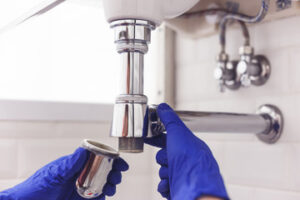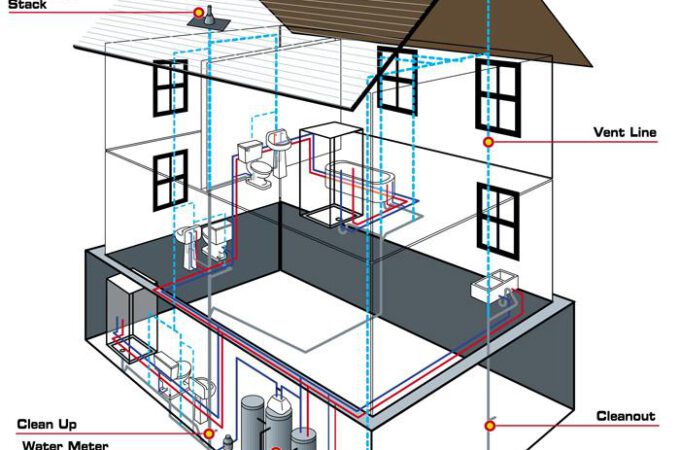What Is Plumbing?
Plumbing encompasses homes and businesses’ water supply, sewage, and drainage systems. Strict codes and standards regulate it to ensure functionality and sanitation.
Well-functioning plumbing contributes to public health by reducing the spread of waterborne diseases. It also improves living conditions by providing hot showers and clean water for washing and cooking. Visit Website to learn more.

A plumbing system comprises supply, drainage and venting components that bring safe, potable water into buildings and remove waste without contaminating the drinking supply. It is more complex than a homebuyer might expect, and it’s crucial for modern life. Most cities and towns have public systems that deliver drinking water to homes and businesses via a network of pipes buried underground. Private plumbing systems connect to these main pipes through a series of fittings. A plumber who specializes in installation works with these pipes to make sure they are properly fitted and sealed.
Plumbing systems are made up of supply, drainage, and venting parts that allow buildings to have safe, drinkable water and remove waste without tainting the water supply. It’s essential to modern life, but it’s more complicated than a prospective homeowner might think. The majority of towns and cities have public water systems that use an underground network of pipes to supply drinking water to residences and commercial buildings. Through a number of fittings, private plumbing systems are connected to these main pipes. When working with these pipes, an installation-focused plumber ensures that they are correctly installed and sealed.
New construction plumbing starts with setting the sewer accommodation stubs, which allow the home’s drain line to connect to the public sewerage system. Then the plumbers begin what’s known as the rough-in plumbing phase, where basic lines are laid before drywall is installed. This includes laying pipe for water supply, drains and venting, along with any fixtures that are to be installed such as toilets, bathtubs, showers and sinks. The plumbers also check that all wiring is clear and that there is enough space for the piping before they cut away drywall to expose the piping.
Plumbers also install plumbing in commercial and industrial settings. These systems are larger than those in residential properties and may involve complicated heating, cooling and fire sprinkler systems. Plumbers in these environments work with engineers and architects to design a system that will meet the building’s needs. They also consult with owners to determine if the existing infrastructure is suitable for upgrades.
Plumbing installation is a bit of an art form. The best plumbers create systems that are quiet, efficient and leak free. This requires careful planning and thoughtful construction. For example, a plumber might plan the location of valves and fixtures to minimize the number of holes in walls and floors. He might even consider the acoustic properties of different pipe materials to ensure his work doesn’t disturb occupants.
It is a good idea for homeowners to get familiar with their plumbing system by understanding what each component does. This way, they can recognize possible problems and take action before the problem gets out of hand. In addition, homeowners should have their plumbing inspected regularly by professional plumbers, even if there are no apparent problems. Regular inspections can help prevent major problems, such as pipe leaks and flooding, from occurring in the future.
Plumbing repair services correct issues with the water supply, drainage, and sewer systems in a home or commercial building. These include the pipes, faucets, and fixtures that provide clean drinking water and remove waste and sewage. A plumber may also repair or install appliances like water heaters. Some common plumbing problems are leaks, clogs, and water pressure issues. Plumbing repair often involves working with hazardous materials, so it is important to hire a plumber with experience and training.
Leaking pipes are among the most common plumbing repairs. Homeowners can often fix small leaks with epoxy putty, but large leaks may require replacing the entire pipe section. Plumbers can test the water pressure in a house to determine whether or not a pipe needs to be replaced. They can also replace a damaged toilet flapper or float ball to prevent the endless running of the toilet.
Clogged drains and sewer lines are another common plumbing issue that plumbers repair. Homeowners can use drain snakes and plungers to break up and clear minor clogs, but more serious blockages may require professional intervention. Plumbers can also install or repair water filters to improve the quality of household water.
A plumbing system is complex, and the pipes that carry water and waste are particularly vulnerable to damage and deterioration. Regular maintenance is essential for keeping a plumbing system in good condition. Plumbing maintenance can prevent small issues from becoming big problems, and it can also save money on utility bills. Some plumbing maintenance tasks that can be performed by a homeowner include cleaning out drain traps, ensuring that water valves are in good working condition, and checking for any corrosion or leaks in the pipes.
A home’s plumbing system is complex and essential. It provides clean, potable water for drinking and cooking; removes waste through drainage systems; and ensures that a building’s structure is protected from damage caused by leaks or overflow. In order for a plumbing system to function properly, it must be properly maintained.
Regular maintenance and prompt attention to problems will help prevent costly repairs down the road. While you can do some of the simple maintenance tasks yourself, like cleaning drains and keeping track of your water usage, it is usually best to leave the more complicated issues to a professional plumber.
Plumbers can perform a number of different services, including inspecting and testing water pressure, fixing leaks, installing new fixtures or appliances, and ensuring that existing ones are functioning correctly. They can also assist with sewer line inspections and repair, by using specialized tools to locate problems and determine their severity.
Leaks and overflows are among the most common plumbing issues. These can lead to flooding, water damage, and health issues from unclean water. Plumbers can use a variety of methods to repair leaks, such as sealing joints and replacing worn washers. They can also clear obstructions in drain lines by using high-powered flushing equipment.
The plumbing system of a building includes all the pipes, fixtures, and devices that are used to distribute water and remove waste. This includes toilets, faucets, showers, appliances, and even the water heater. Plumbing is regulated by strict laws and codes to ensure safety and functionality. A faulty plumbing system can lead to water damage, mold growth, and even structural damage.
Plumbing issues are a fact of life for homeowners, but that doesn’t mean they have to be expensive or inconvenient. By learning some basic troubleshooting tips and performing routine maintenance, you can keep your plumbing system running smoothly for years to come. And remember, if you do run into a problem, it’s always best to call a plumber right away. They can save you time, money, and a lot of headache! With a little knowledge, it’s easy to fix many minor plumbing problems yourself.
The plumbing system is crucial for our daily lives, providing us with clean water and removing waste. Without it, people would have difficulty washing, cooking, and cleaning. In addition, sewage and waste would build up in the building, posing health risks and reducing the quality of life.
A home’s plumbing system is comprised of a network of pipes, tanks, faucets, valves, and fixtures that facilitate the transport of water. While it’s easy to take for granted, this complex system requires regular maintenance and replacement parts to function properly.
Some telltale signs that your plumbing is in need of replacement include discolored or bad tasting water, clogged drains, and toilets that don’t flush. Whether it’s due to age, the materials used in your plumbing, or environmental factors, eventually your pipes will wear out and need to be replaced. Replacing your plumbing with newer, more durable materials can help reduce future problems and ensure that your water is safe to drink. Depending on the scope of the project, replacing your plumbing can be an expensive undertaking. However, implementing preventative maintenance can minimize the cost of plumbing system replacement. The experts can provide tips and advice on how to keep your plumbing systems running smoothly for as long as possible.

